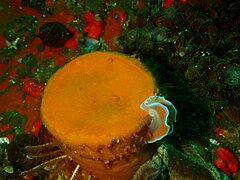The dive site Giant's Castle is an offshore rocky reef in the Miller's Point area of False Bay on the east side of the Cape Peninsula, near Simon's Town, a suburb of Cape Town in the Western Cape province of South Africa.
Understand
edit

This is one of the deeper reef sites within a short distance from the popular False Bay launching areas.
Position
edit1 Giant's Castle: S34°14.362' E018°29.225'. (17 m pinnacle): About 350 m ESE of the blinder at Outer Castle
This site is entirely inside the Castle Rocks Restricted Zone of the Table Mountain National Park Marine Protected Area (2004). A permit is required.
Name
editThe name "Giant's Castle" was given by the divers on the first recorded dive to this site skippered by Graeme on the Pisces dive boat. The site was first surveyed in detail in August 2016, but was already shown as a patch of reef on the Council for Geoscience side-scan sonar survey made some years previously (dotted red outlines on the maps).
Depth
editMaximum depth is reported as about 33 m, probably on the sand to the east of the reef, and the top of the highest pinnacle is about 17 m. Average depth of a dive is likely to be about 24 m.
Visibility
editVisibility is likely to be similar to the other reefs in the Miller's Point area, but may be better due to less surge at depth, but darker, due to greater average depth.
Topography
editThe reef is quite compact, being roughly 70 m from east to west, and 50 m from north to south, with an irregular perimeter and surrounded by fairly flat sand. The group of tall pinnacles is to the west of the reef, and is made up of a tight group of tall outcrops and boulders up to 10 m high, partly separated by narrow, deep gullies, rising from low reef or sand.
Geology: Pre-Cambrian Granite of the Peninsula pluton, surrounded by mostly fine quartzitic sand and shell fragments.
Conditions
editThe site is exposed to swell from the south and south-east, and to wind chop from the north-west, so should be dived in westerly swells, and preferably in moderate winds.
The site will generally be at its best in winter but there are also occasional opportunities at other times of the year.
Get in
editAccess is by boat. The site is about 1.9 km from Miller's Point slipway, or 9.2 km from Simon's Town jetty
See
editMarine life
editThe top of the reef is heavily encrusted with black mussels, possibly the invasive alien Mediterranean mussel, Mytilus galloprovincialis, but from about 20 m downwards this opens up to more typical reef ecology of this area and depth range, with moderate numbers of sea fans, reef fish, sea anemones and the usual starfish, sea cucumbers, feather stars and brittlestars, including a few basket stars.
- Black mussels, possibly Mytilus galloprovincialis, at the pinnacle
- Sunburst soft coral Malacacanthus capensis with frilled nudibranch Leminda millecra
- Cauliflower soft coral Eunephthya thyrsoidea
- Grey starfish Callopatiria formosa
Photography
editThe site will generally provide good opportunities for macro photography, but on a really good day, the topography should be good for scenic wide-angle shots. Artificial lighting will usually be necessary.
Suggested routes
editFor your first dive at the site there is plenty to look at around the pinnacles, and on the sand nearby. For subsequent dives it may be worth exploring the unmapped eastern parts of the reef, or the lower profile outliers to the north.
Stay safe
editHazards
editNo site-specific hazards have been reported, though the site is in an area of relatively heavy small-boat traffic when fishing is good.
Skills
editNo special skills are needed, though the ability to deploy a DSMB is recommended so that the dive boat can keep track of you during ascent, and so that passing boat traffic can avoid you.
Equipment
editA DSMB and reel is recommended for safety reasons, a good wetsuit or dry suit will keep you warmer longer, and Nitrox will allow a longer bottom time.
Nearby
edit- 1 Miller's Point tidal pool
- 2 Murphy's
- 3 Boat Rock
- 4 Festival Pinnacle
- 5 Fan Reef
- 6 Shark Alley
- 7 Pyramid Rock
- 8 Phone reef
- 9 Super Fan Reef
- 10 Outer Castle
- 11 Zigzag Reef
- 12 North Pie Rock Reef
- 13 West Pie Rock Reef
- 14 Castle Rocks Point Reefs
- 15 South Pie Rock Pinnacles
Back to the Alphabetical list of sites, or list of dive sites in the Castle Rocks area
Other regional dive sites:
- Dive sites of Table Bay and approaches,
- Dive sites of the Cape Peninsula west coast
- Dive sites of False Bay offshore and approaches
- Dive sites of False Bay east coast
- Fresh water dive sites of the Cape Town Metropolitan Area





